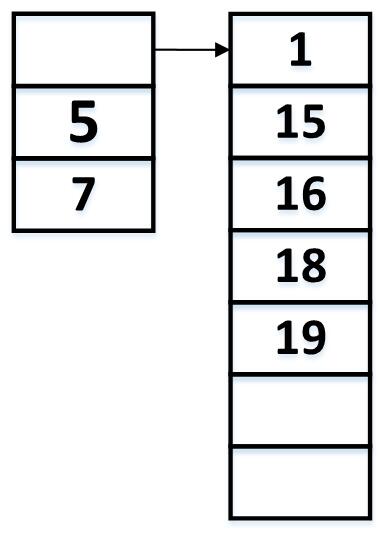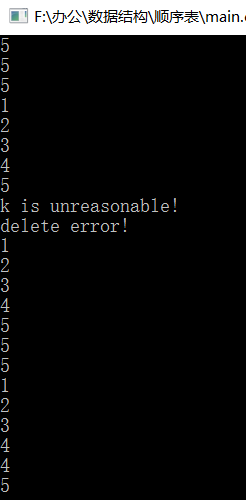C++数据结构学习之顺序表
顺序表是数据结构中最基本也是应用相当广泛的一种数据结构类型。它通常包含三个私有成分,即指向数据数组的头指针、当前表长以及表的实际容量。表的头指针通常指向数据数组的基地址,通过数组的形式进行访问数据数组中的每个元素。其基本结构类型如下图所示:

从上图可以看到,其基本结构包含一个指向数据数组的头指针,当前表长为5,但是该顺序表实际表的容量有7。
下面附上实现该数据结构的各项操作代码
在C.h文件中存放可能要用到的C++库:
#ifndef _C_H_
#define _C_H_
#include<iostream>
#include<fstream>
#include<iomanip>
#include<cmath>
#include<vector>
#include<list>
#include<stack>
#include<queue>
#include<deque>
#include<string>
#include<bitset>
#include<algorithm>
#include<ctime>
#include<cstdarg>
#include<assert.h>
using namespace std;
#endif // _C_H_
在SequenceTable.h存放对应的数据结构类型:
#ifndef _SEQUENCETABLE_H_
#define _SEQUENCETABLE_H_
template<typename T>class STL{
private:
T *elem; //save the base address of STL
int length; //save the current length of STL;
int listsize; //save the opacity of STL
public:
//a function to create k length STL, if k doesn't exist, it can use default function to create 1 length STL
STL(int k=){
elem = new T[k];
length = ;
listsize = k;
}
//destruct STL
~STL(){
delete[]elem;
}
int getLength();
int getListsize();
void Insert(int k, int data); //a function to insert elem in the specific location
void Delete(int k, int data); //a function to delete elem in the specific location
int getElem(int k); //get elem in the specific location
int getLocation(int data);
void ListEmpty();
void showSTL();
}; template<typename T>
int STL<T>::getListsize(){
return listsize;
} template<typename T>
int STL<T>::getLength(){
return length;
} template<typename T>
void STL<T>::Insert(int k, int data){
//confirm whether the k is reasonable
if(k <= || k > (length+)){
cout<<"k is unreasonable!"<<endl;
}
int t; //an empty bottle
//insert data while satisfy this situation
while(length<listsize && k<=length){
if(k<length){
t = elem[k];
elem[k] = data;
data = elem[k+];
k++;
}
else{
length++;
t = elem[k];
elem[k] = data;
data = elem[k+];
k++;
}
}
if(k==(length+)){
if(length<listsize){
length++;
elem[k] = data;
}
else{
listsize++;
length++;
elem[k] = data;
}
}
} template<typename T>
void STL<T>::Delete(int k, int data){
//confirm whether the k is reasonable
if(k <= || k > (length+)){
cout<<"k is unreasonable!"<<endl;
}
//insert data while satisfy this situation
if(elem[k]==data){
while(k<=length){
if(k<length){
elem[k] = elem[k+];
k++;
}
else{
k++;
}
}
length--;
}
else{
cout<<"delete error!"<<endl;
}
} template<typename T>
int STL<T>::getLocation(int data){
int i = ; //consider when the length is 0 but the listsize is 1
while(i<=length){
if(elem[i] == data){
return i;
}
i++;
}
} template<typename T>
int STL<T>::getElem(int k){
if(k<= || k>=(length+)){
cout<<"k is unreasonable!"<<endl;
}
else{
return elem[k];
} } template<typename T>
void STL<T>::ListEmpty(){
length = ;
} template<typename T>
void STL<T>::showSTL(){
for(int i=;i<=length; i++){
cout<<elem[i]<<endl;
}
}
#endif
然后再main.cpp文件中实现对该数据结构的调用:
#include "C.h"
#include "SequenceTable.h"
typedef int T;
int main(){
STL<T> L;
for(int i=; i<;i++){
L.Insert(i+, i+);
}
cout<<L.getLocation()<<endl;
cout<<L.getLength()<<endl;
cout<<L.getListsize()<<endl;
L.showSTL();
int a = L.getElem();
L.Delete(,);
L.showSTL();
cout<<L.getLength()<<endl;
cout<<L.getListsize()<<endl;
L.Delete(,);
L.showSTL();
cout<<L.getLength()<<endl;
cout<<L.getListsize()<<endl;
}
运行实现:

C++数据结构学习之顺序表的更多相关文章
- C++ 数据结构学习一(顺序表)
//SequentialList.h 顺序表模板类 #ifndef SEQUENTIAL_LIST_HXX#define SEQUENTIAL_LIST_HXX using std::cout; us ...
- 【数据结构】之顺序表(Java语言描述)
之前总结过使用C语言描述的顺序表数据结构.在C语言类库中没有为我们提供顺序表的数据结构,因此我们需要自己手写,详细的有关顺序表的数据结构描述和C语言代码请见[我的这篇文章]. 在Java语言的JDK中 ...
- 【数据结构】之顺序表(C语言描述)
顺序表是线性表的一种,它将元素存储在一段连续的内存空间中,表中的任意元素都可以通过下标快速的获取到,因此,顺序表适合查询操作频繁的场景,而不适合增删操作频繁的场景. 下面是使用 C语言 编写的顺序表的 ...
- C语言学习笔记-顺序表
#include "stdafx.h" #include <stdio.h> #include <stdlib.h> #include "coni ...
- 数据结构 单链表&顺序表
顺序表: 一般使用数组(C语言中的数组采用顺序存储方式.即连续地址存储)来描述. 优点:在于随机访问元素, 缺点:插入和和删除的时候,需要移动大量的元素. 链表: 优点:插入或删除元素时很方便,使用灵 ...
- 数据结构——Java实现顺序表
一.分析 什么是顺序表?顺序表是指用一组地址连续的存储单元依次存储各个元素,使得在逻辑结构上相邻的数据元素存储在相邻的物理存储单元中的线性表.一个标准的顺序表需要实现以下基本操作: 1.初始化顺序表 ...
- 数据结构之线性顺序表ArrayList(Java实现)
一.ListMe接口: import java.util.ArrayList; //实现线性表(顺序表和链表)的接口://提供add get isEmpty size 功能public interfa ...
- 数据结构之动态顺序表(C实现)
线性表有2种,分为顺序表和链表. 顺序表: 采用顺序存储方式,在一组地址连续的存储空间上存储数据元素的线性表(长度固定) 链表: 有3种,单链表.双向链表.循环链表(长度不固定) seqList.h ...
- 【c++版数据结构】之顺序表的实现
SeqList.h #ifndef SEQLIST_H #define SEQLIST_H #include<iostream> using namespace std; typedef ...
随机推荐
- 番外篇--Moddule Zero安装
Moddule Zero 安装 1.2.1 从模板创建 使用ABP和module-zero开始一个新项目最简单的方式是使用启动模板.详细了解请参考启动模板文档. 1.2.2 手动安装 如果你有一个预先 ...
- 【转载备忘】PowerDesigner16.5基本使用
这两天都在设计数据库,使用了powerdesigner进行设计的,然后摸索了好久,本来打算写一篇文章来记述一下的,写了一半,突然发现网上早就有比我写的好的文章了,所有删了之前写的,直接贴出来那个文章的 ...
- 【深度学习系列】PaddlePaddle可视化之VisualDL
上篇文章我们讲了如何对模型进行可视化,用的keras手动绘图输出CNN训练的中途结果,本篇文章将讲述如何用PaddlePaddle新开源的VisualDL来进行可视化.在讲VisualDL之前,我们先 ...
- phpmyadmin 自动登录的办法
在本地开发php项目中,需要配合使用mysql在线管理系统phpmyadmin,因为经常使用,就不想每次都输入密码,所以想办法把用户名密码写入配置文件中,让每次都可以自动登录. 工具/原料 代码编 ...
- 织梦dede在首页调用留言本
织梦dedecms在首页调用留言本 . {dede:loop table=dede_guestbook sort=dtime row=10 titlelen=36 typeid=40 if=ische ...
- XHR
xhr注入 XHR 注入技术是通过XMLHttpRequest来获取javascript的.但与eval不同的是,该机制是通过创建一个script的DOM元素,然后把XMLHttpRequest的响应 ...
- Java中的对象Object方法之---wait()和notifiy()
这一篇咋们继续,接着来介绍wait()和notify()方法,我们都知道这两个方法和之前介绍的方法不太一样,那就是这两个方法是对象Object上的,不属于Thread类上的.我们也知道这两个方法是实现 ...
- MyBatis 查询示例
环境搭建 数据库schema 1)datasource.xml配置 <?xml version="1.0" encoding="UTF-8"?> & ...
- [转]另一种遍历Map的方式: Map.Entry 和 Map.entrySet()
转自: http://blog.csdn.net/mageshuai/article/details/3523116 今天看Think in java 的GUI这一章的时候,里面的TextArea这个 ...
- java里程碑之泛型--擦除和转换
在严格的泛型代码里,带泛型声明的类总应该带着泛型参数.但是为了和古老的java代码保持一致,也就是说为了向下兼容,也允许在使用带泛型声明的类时不指定实际的类型参数.如果没有为这个泛型类指定实际的参数类 ...
